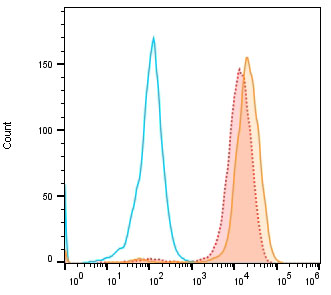High lot-to-lot consistency
Increased sensitivity and higher affinity
Animal-free production
Description:
Anti-BCMA, AlpHcAbs® Human antibody is designed for detecting human, cynomolgus or alpaca BCMA/TNFRSF17 specifically. Anti-BCMA, AlpHcAbs® Human antibody is recombinant VHH domain of alpaca IgG2b/2c fused to Human IgG1 Fc. Based on ELISA, Anti-BCMA, AlpHcAbs® Human antibody reacts with human BCMA, and has reactivity with cynomolgus or alpaca BCMA.
Immunogen: Recombinant human BCMA/TNFRSF17
Host: Alpaca pacous
Isotype: VHH domain of alpaca IgG2b/2c fused to Human IgG1 Fc(mutation)
Conjugate: Unconjugated
Specificity: Human BCMA
Cross-Reactivity: Cross-reactivity with cynomolgus or alpaca BCMA
Purity: Recombinant Expression and Affinity purified
Concentration: 1mg/ml
Formation: Liquid, 10mM PBS (pH 7.5), 0.05% sucrose, 0.1% trehalose, 0.01% proclin300,50% Glycerol
Storage: Store at –20 °C, (Avoid freeze / thaw cycles), Stable for 12 months at -20°C
Background:
BCMA, B cell maturation, is a member of the TNF receptor superfamily. It has been designated TNFRSF17. BCMA is a type III membrane protein containing one extracellular cysteine rich domain. Within the TNFRSF, it shares the highest homology with TACI. BCMA and TACI have both been shown to bind to APRIL and BAFF, members of the TNF ligand superfamily. BCMA expression has been found in immune organs and mature B cell lines. Although some expression has been observed at the cell surface, BCMA appears to be localized to the Golgi compartment. The binding of BCMA to APRIL or BAFF has been shown to stimulate IgM production in peripheral blood B cells and increase the survival of cultured B cells. This data suggests that BCMA may play an important role in B cell development, function and regulation. Human BCMA is a 184 amino acid(aa) protein consisting of a 54 aa extracellular domain, a 23 aa transmembrane domain, and a 107 aa intracellular domain.
Using antibody with Fc(mutation), the background from Fc receptors will be eliminated.
ELISA: 1:4,000-1:10000
Flow Cytometry:1:200-1:1000
Dilution factors are presented in the form of a range because the optimal dilution is a function of many factors, such as antigen density, permeability, etc. The actual dilution used must be determined empirically.



